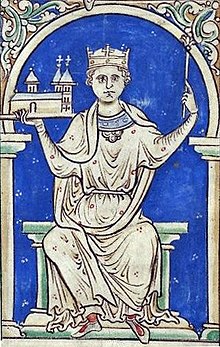
Back Stefanus van Engeland Afrikaans Stēfan Engla Cyning ANG ستيفن (ملك إنجلترا) Arabic ستيفن ملك انجلترا ARZ استیون (اینگیلیس) AZB Стэфан (кароль Англіі) Byelorussian Стивън (Англия) Bulgarian Steven (Bro-Saoz) Breton Stjepan, kralj Engleske BS Esteve d'Anglaterra Catalan
| Stephen | |
|---|---|
 Miniature from Matthew Paris's Historia Anglorum | |
| King of England | |
| Reign | 22 December 1135 – 25 October 1154 |
| Coronation | 22 December 1135 & 25 December 1141 |
| Predecessor | Henry I |
| Successor | Henry II |
| Contender | Matilda (1141–1148) |
| Born | Stephen of Blois 1092 or 1096 Blois, Kingdom of France |
| Died | 25 October 1154 (aged 57–58 or 61–62) Dover, Kent, Kingdom of England |
| Burial | Faversham Abbey, Kent, England |
| Spouse | |
| Issue more... | |
| House | Blois |
| Father | Stephen, Count of Blois |
| Mother | Adela of Normandy |
Stephen (1092 or 1096 – 25 October 1154), often referred to as Stephen of Blois, was King of England from 22 December 1135 to his death in 1154. He was Count of Boulogne jure uxoris from 1125 until 1147 and Duke of Normandy from 1135 until 1144. His reign was marked by the Anarchy, a civil war with his cousin and rival, the Empress Matilda, whose son, Henry II, succeeded Stephen as the first of the Angevin kings of England.
Stephen was born in the County of Blois in central France as the fourth son of Stephen-Henry, Count of Blois, and Adela, daughter of William the Conqueror. His father died while Stephen was still young, and he was brought up by his mother. Placed into the court of his uncle Henry I of England, Stephen rose in prominence and was granted extensive lands. He married Matilda of Boulogne, inheriting additional estates in Kent and Boulogne that made the couple one of the wealthiest in England. Stephen narrowly escaped drowning with Henry I's son, William Adelin, in the sinking of the White Ship in 1120; William's death left the succession of the English throne open to challenge. When Henry died in 1135, Stephen quickly crossed the English Channel and, with the help of his brother Henry, Bishop of Winchester and Abbot of Glastonbury, took the throne, arguing that the preservation of order across the kingdom took priority over his earlier oaths to support the claim of Henry I's daughter, the Empress Matilda.
The early years of Stephen's reign were largely successful, despite a series of attacks on his possessions in England and Normandy by David I of Scotland, Welsh rebels, and the Empress Matilda's husband Geoffrey Plantagenet, Count of Anjou. In 1138, the Empress's half-brother Robert of Gloucester rebelled against Stephen, threatening civil war. Together with his close advisor, Waleran de Beaumont, Stephen took firm steps to defend his rule, including arresting a powerful family of bishops. When the Empress and Robert invaded in 1139, Stephen was unable to crush the revolt rapidly, and it took hold in the south-west of England. Captured at the battle of Lincoln in 1141, he was abandoned by many of his followers and lost control of Normandy. He was freed only after his wife and William of Ypres, one of his military commanders, captured Robert at the Rout of Winchester, but the war dragged on for many years with neither side able to win an advantage.
Stephen became increasingly concerned with ensuring that his son Eustace would inherit his throne. The King tried to convince the church to agree to crown Eustace to reinforce his claim; Pope Eugene III refused, and Stephen found himself in a sequence of increasingly bitter arguments with his senior clergy. In 1153, the Empress's son Henry invaded England and built an alliance of powerful regional barons to support his claim for the throne. The two armies met at Wallingford, but neither side's barons were keen to fight another pitched battle. Stephen began to examine a negotiated peace, a process hastened by the sudden death of Eustace. Later in the year Stephen and Henry agreed to the Treaty of Winchester, in which Stephen recognised Henry as his heir in exchange for peace, passing over William, Stephen's second son. Stephen died the following year. Modern historians have extensively debated the extent to which his personality, external events, or the weaknesses in the Norman state contributed to this prolonged period of civil war.